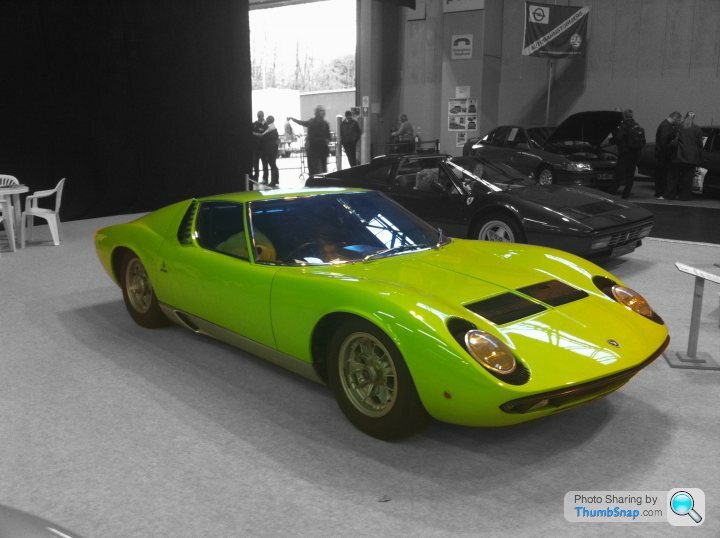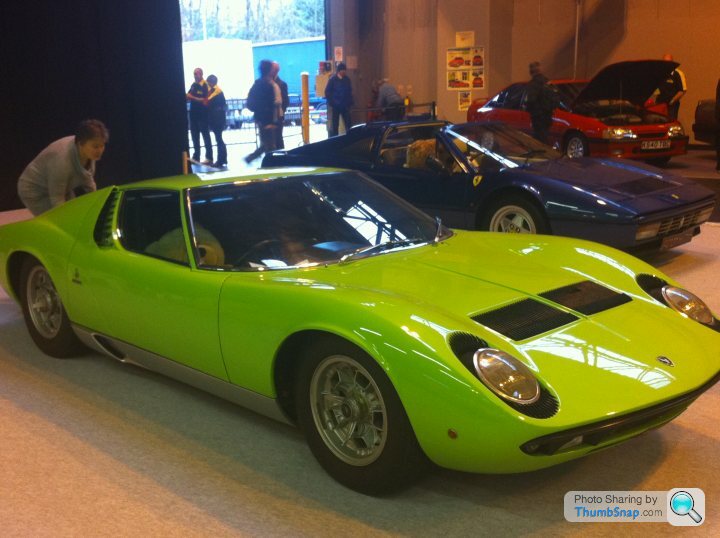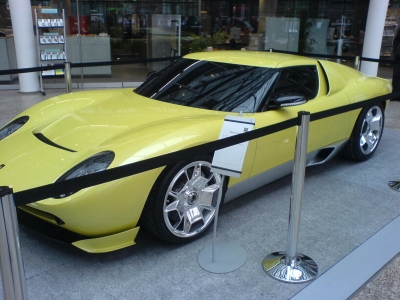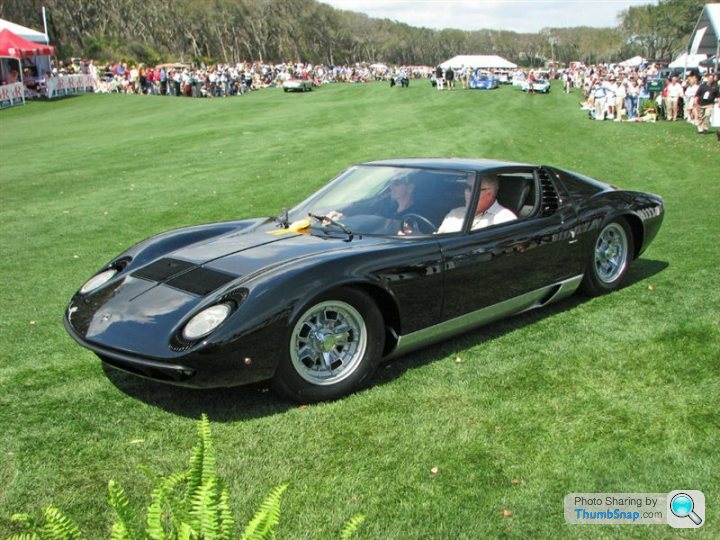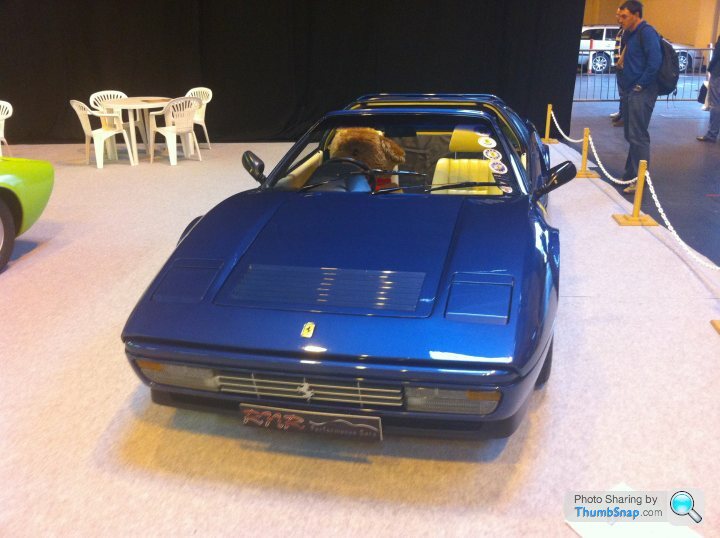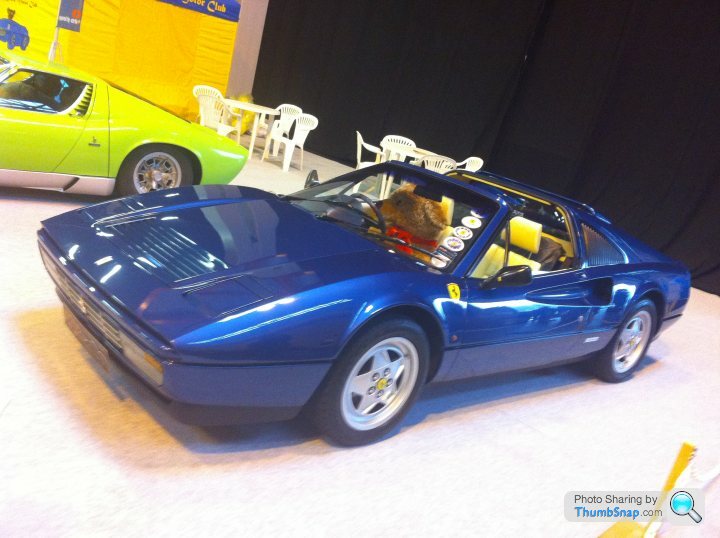Lamborghini Miura | PH Heroes
The iconic Lamborghini proves a car doesn't have to be good to be great

Beauty: the stuff of subjectivity. One man's gorgeous, another man's gargoyle, and all that. Yet pretty much without fail, whenever there's a poll of automotive elegance and visual desire, sitting atop the list, or very near the summit, is the Lamborghini Miura. True beauty, it would seem, seduces universally.
Even among Lamborghini's current outrageous offerings, the Miura stands out, its proportions near perfect, its curves drawn tightly enough around the chassis to suggest they were formed for mere purpose, and yet smooth and flowing and emotion-wrenching, as though inspired by pure, artistic desire. To spot a Miura parked up is to spot a large crowd of appreciative spectators, drawn to it by the magnetism of sheer star quality: it's a four-wheeled celebrity, though unlike others whose heyday was more than 40 years ago, the Lambo's ravishing good looks haven't required the services of Botox or cosmetic surgery to retain their youthful glow.
What makes the Miura's attractiveness all the more compelling is the fact that the car's styling played second fiddle to the package of engineering underneath it. Back in the mid-1960s, Lamborghini's freshly appointed chief engineer, Gian Paolo Dallara (yes, now of F3 and Indycar fame), was tasked with creating a new sports car, powered by a quad-cam V12 designed by freelance engineer Giotto Bizzarrini. At that time road-going sports cars tended to have longitudinally mounted engines, but so inspired was Dallara by the transverse location of the Mini's engine and its combined gearbox and final drive, that he effectively copied the idea, although turning it around to create a mid-engined design.
A rolling chassis was constructed and displayed on Lamborghini's 1965 Turin Show stand: only after that was Bertone - and in particular its in-house stylist, Marcello Gandini - brought on board to clothe the hardware. Normally things happen the other way around, but having to work within given parameters didn't seem to handicap Gandini very much.
Given how iconic the Miura has since become, it's astonishing that it was completed in just seven months. And by a core development team of just seven people. All of whom were just 20-somethings. In an interview in Evo a few years ago, Dallara explained how such a thing was possible: "We were a very young and inexperienced team and therefore didn't realise the enormity of the task." Goes to show how much better cars can be when they're produced by a small team rather than a large and cumbersome committee.
Not that the Miura traded solely on looks. Its quoted performance of 180mph - fanciful though that may have been - helped it establish an entirely new strata of sports car, that of the supercar. It sort of didn't matter that the Lambo would probably lift clean off the ground at anything approaching that speed, because all its rivals were also dealing in inflated performance and power figures, and to challenge the looker from Sant'Agata would be to risk exposing their own little white lies. The other factor that elevated the Miura to another marketing dimension was its price - in the UK in 1967, the mid-engined marvel cost £8050, at a time when a Jaguar E-type was less than £2000. Supercar indeed...
In an era of Ford Cortinas and Morris Minors the Miura must have seemed impossibly exotic, so it's fitting that the car pictured here once belonged to Twiggy; owned by her but, it seems, more often driven during the 1960s by her manager, Justin de Villeneuve. Also on the V5's list of previous keepers is a certain Mr B. Ecclestone. Current owner is JHW Classics, which acquired the car for its collection more than a decade ago, after a long hunt for the right example.
Even in colours less vibrant than JHW's car, the Miura remains compelling viewing. It's very low - its rooftop is just 51 inches above the tarmac, even on fat 'period' rubber - and it's very wide, while the slatted cover over the engine bay and the 'lashes' around its exposed, pop-up headlights are distinguishing features that every schoolboy of a certain age can recite.
Getting in isn't quite the struggle that it might be in more modern supercars or even some (Lotus) sports cars: side impact protection wasn't an issue back in the 1960s and bodyshell rigidity was a fledgling science, so the Miura does without large, obstructive sills. Mind you, it's still a long way down to the seats, and when you get there you find that the fixed seat back and thin padding don't bode well for long distance comfort. Neither, if you're tall, does the rake of the roofline, which falls away sharply as it travels aft, slicing off headroom as it goes. As for luggage space, well, it might be as well that you send your manservant ahead...
It's all-black in here, in a retro-but-for-the-reason-that-you-don't-really need-anything-more way. A sextet of dials off to your left, looming above the fat transmission tunnel. A thin-rimmed steering wheel ahead, a bit too high and a bit too tilted forward, yet not so much so that a tantrum's needed. The gearlever spearing down to an open gate is nicely positioned, while thanks to slender A-posts, forward visibility is excellent.
Behind you - barely - is that transversely-mounted V12, a 4.0-litre unit with a quartet of slurping carbs, rated at the time at 350bhp, though cynics might rightly doubt the pedigree of some of those Italian ponies... Again, though, it hardly matters. The Miura weighs less than a ton and has sharpness of throttle response that modern cars can only cast longing, misty eyes at. This bull rampages when you ask it, feels genuinely fast even in the modern idiom. Not 21st century supercar quick, but in no way disappointing and requiring context only in a minor way.
The V12 whoops and shrieks and fills your head with sound, your mind with visions of old-school racing cars from the days when 7500rpm was a full-on engine speed. You have to want the engine to dish out its power, though, because the accelerator pedal is as heavy as the brakes, and while the gearshift is nifty, you have to exercise precise movement to get it briskly across the gate. But this is all part of engaging with the Miura, having to work with it to earn your rewards, rather than have them handed to you on a silicone chip, as is the modern way.
A few years ago Lamborghini showed a modern interpretation of the Miura and the world went mental for it. And it seemed a brilliant proposition: an iconic shape mated to modern performance and convenience. When the concept was declared to be nothing more than that - a concept - I thought Lamborghini had missed out on a golden opportunity.
But meet the original and you realise that Lamborghini was right. The Miura can't be improved or replicated. A modern Miura would be hamstrung by modern regulations and marketing considerations, and bit by bit all the things that make its whole so wonderful, would be compromised. Its spirit would be eroded. Passion would be replaced with pragmatism. Yes, it makes the original cars ever-more valuable and unobtainable, but then that's part of what has always made the Miura so special - not every Tom, Dick and Footballer can have one.
Even if you can't own one or drive one, the soul and emotion of the Miura is still available to anyone with a DVD player - simply slip in a copy of The Italian Job (the original version) and immerse yourself in the opening sequence. The road, the scenery, the music, the engine note, the sunglasses, the sheer joyousness of the Miura experience is there, available to all. Just remember to press pause when the tunnel looms...
Our thanks go to JHW Classics for all their help with this feature.
To see this Lamborghini Miura in the flesh, then get yourself down to Chelsea AutoLegends on Sunday (4 September), at the Royal Hospital Chelsea, London SW3 4SR.
PistonHeads is sponsoring the Supercar Convoy of Chelsea AutoLegends - which this year has the theme of 'The Swinging Sixties' - and as well as the Miura you'll be able to see a staggering array of some of the world's most iconic sports cars, supercars and extreme rally legends.
Why no door mirrors though?
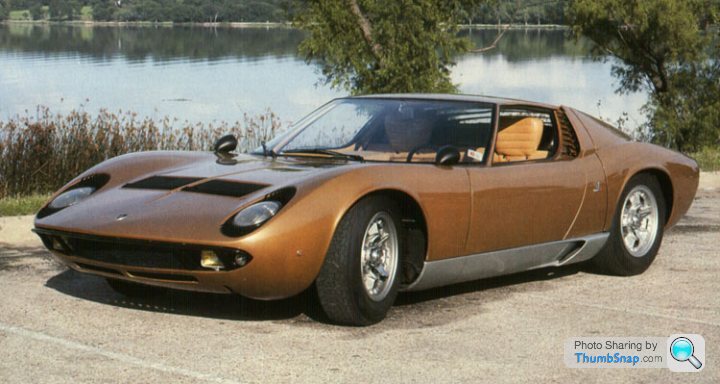
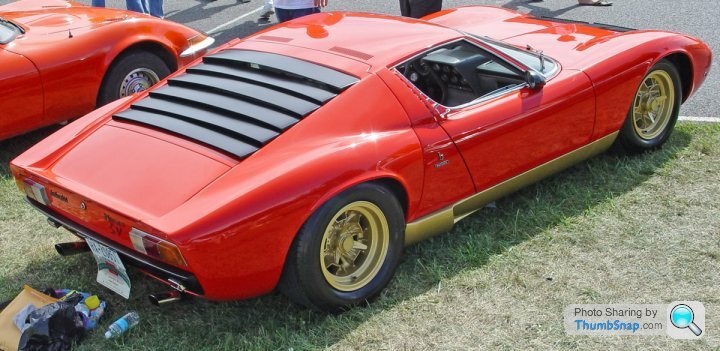
What's the best 1:18 scale model on the market for real world (£50 or less) money?
The yellow one sold in 1985, this was quoted at the time "Only 142 SVs were made, nine of which were right-hand-drive. Stewart kept his until 1985. During that time it appears to have played a significant part in his lifestyle-when he sold it, there were marks from stiletto heels in the headliner. If this car could talk it might bring a blush to the cheeks of many a glamorous model and actress."
Still maybe the best looking car ever made IMHO.
On days like these indeed........

"Rock-and-roll star Rod Stewart was no stranger to the Lamborghini Miura, the world's first mid-engined supercar-he has owned both a Miura S and SV. When he ordered the right-hand drive SV shown here, he specified a bright yellow finish with dark blue leather upholstery. He also ordered air conditioning, which was relatively novel on a GT car, and a Philips radio/cassette with a recording function.
Only 142 SVs were made, nine of which were right-hand-drive. Stewart kept his until 1985. During that time it appears to have played a significant part in his lifestyle-when he sold it, there were marks from stiletto heels in the headliner. If this car could talk it might bring a blush to the cheeks of many a glamorous model and actress."
Here's the yellow one..... (factory restored to new condition)

When the second owner bought the car in 1985 it had 18,000 miles on the clock and he undertook a sympathetic restoration. The chassis and body were stripped and the coachwork repainted in the correct shade of yellow, with the cabin retrimmed in blue Connolly to match the original. Del Hopkins fitted new carburetors and the suspension was rebuilt. The engine was found to be in excellent condition so was serviced rather than opened. Being a late-production SV, it of course has the desirable split-sump lubrication.
Since completion of this work, Rod Stewart's Miura SV has covered another 11,000 miles. It was featured in Classic Cars magazine in January 1995, where it was summed up as "an intrinsically special car to jump into and drive whenever you need to feel good about the world."
S/N 4818 still has Rod Stewart's name in the logbook, plus the SV Owner's Handbook and a file of invoices. A copy of the Coltrin/Marchet Miura book is also included, signed by Ferruccio Lamborghini, for the vendor.
This car sold for $122,460, including buyer's premium, at the Bonhams Goodwood auction, September 6, 2002.
Lamborghini's Chief Development Engineer, Bob Wallace, built the legendary one-off Miura Jota in 1969 as an experimental project sanctioned by Chief Engineer Paolo Stanzini. Some of the technical knowledge gained in the project was employed for the Miura's ultimate version, the Miura P400SV. The SV, introduced at the Geneva Salon of 1971, came to symbolize the very best version of Lamborghini's famous Miura.
The SV (standing for Spinto Veloce, which literally translates to "tuned fast") featured a wider rear track, revised suspension geometry, a reinforced chassis, a split sump separating gearbox and engine oil (employed in the last 96 SVs built), hotter cam timing, bigger inlet valves and upgraded Weber carburetors making power and torque increases to 385 bhp and 289 pounds-feet, respectively.
Cosmetically, the SV received wider 9-inch Campagnolo rear wheels, wider rear fenders, deletion of the grilled "eyelashes" around the headlights, new larger three-section Altissimo taillights and a revised front bumper with parking lamps. The SV's improvements over previous Miuras led Bob Wallace to describe it as a "different car" by comparison in terms of handling and performance.
This car's refurbishment by Del Hopkins is a huge plus, as he is one of a handful of Lamborghini specialists who really know these cars. 4818 is a split-sump car with factory-installed air conditioning-the ultimate specification for a Miura SV, and another point in the car's favor.
4818's only visible exterior fault is the application of the rear SV badges a tad askew (to the left), courtesy perhaps of the time when the car was repainted. Correction involves welding up the holes drilled into the wrong place in the rear aluminum panel, and paintwork before the badges can be correctly repositioned.
Of greater concern is the status of this car's engine. Wallace himself reminds us that these engines were good for about 30,000 miles, which is exactly how far this example has traveled. If 4818's engine has not been opened yet, as the catalog infers, the new owner should expect a very expensive rebuild in the not-too-distant future.
Miura SV values are substantially softer in Europe than in the US, perhaps due to the fact that they seem to come to the marketplace more often (three SVs have been sold by auction in Europe this year with another three advertised for sale). Also, the majority of cars offered there are original, unrestored cars that are simply worth less. By way of example, 4818 brought close to $150,000 less than 5064, a fully restored SV sold by Christie's during Pebble Beach weekend this past August for $270,000, and its $122,460 all-in price should be considered a fantastic bargain for the attentive English car dealer who purchased it. No doubt this car will be on offer in the near future for significantly more than its sale price.
With perhaps 100 examples of roadworthy SVs and just a mere handful of truly well-restored cars in existence, SV values can only go upwards over time. In America a good SV was a $150,000 car five years ago, with a Ferrari Daytona in similar condition being the same price. Today very nice examples of an SV are more like $250,000, with Daytonas bringing only half that number in many cases.-Joe Sackey

1971 Lamborghini Miura P400 SV
s/n 4866 engine no. 30637
Dark Blue with Light Grey Leather Interior
Few cars have stunned like the Miura. Introduced in November of 1965 at the Turin Salon as just a naked chassis, the car created a sensation because of its radical mechanical layout. The sophisticated quad cam V12 was mounted amidships and transversely, creating a compact and balanced platform that went against almost all prior conventions about how to build fast cars. The press was sure Lamborghini was planning a race car, though in reality the car was a hastily conceived exercise to generate publicity. And generate publicity it did. Because of the huge response to the car, Lamborghini decided to build it, though they did not yet have a body. Bertone produced what is surely one of the most beautiful cars ever made and had a prototype ready just four months later, in time to show at Geneva in March of 1966. Orders poured in, and the plan to build perhaps fifty examples was soon scrapped. All told, over seven hundred and fifty Miuras would be built, effectively putting Lamborghini on the map, a shocking achievement considering that the firm was just three years old when the Miura was unveiled.
The car was then taken to Monte Carlo for the Monaco GP, drawing crowds five deep, despite the plethora of other exotic cars on hand and the jaded crowd at the casino. Legendary English journalist L.J.K. Setright took the car on a thousand mile tour of Europe for Car magazine, and called it a “supercar”, inventing the term that survives with us today to describe a very special automotive experience. The Miura was not dynamically perfect, but invented an entire genre of car and captured everything that was wonderful about motoring in the swinging sixties. Who really needs bumpers or proper rear visibility?
It was all about the colors, the style, the performance, and the noise. The response of the public and the press was almost universally effusive, but there were of course foibles, which in typically Italian fashion, would be ironed out as production proceeded. In November of 1968, the Miura became the Miura S, with the introduction of a number of refinements, including reshaping the combustion chambers and altering the camshafts and carburetion, for about twenty more horsepower. Build quality was improved, electric windows added, and a bit more chrome (on the headlights and window trims) was added. The rear suspension was revised, and on later cars, ventilated discs employed for the brakes.
The Miura SV, however, is the ultimate development of the Miura, with examples often commanding nearly twice the price of a comparable Miura S. Visually, the SV is more aggressive thanks to its flared rear fenders and wider rear track (the result of a revised suspension layout and 9-inch wide rear wheels). This provided more grip and improved the handling, while engine revisions to cam profiles, carburetion, and enlarged intakes provided additional power. The lighting was revised front and rear, and the famed eyelashes around the headlamps were also eliminated. The overall visual changes produce a more aggressive and less adorned look.
Around 150 Miura SV’s were built, and this particular car is one of the more famous examples. Equipped with AC, this car was previously owned by Rod Steward in Los Angeles during the 1970’s. This car was purportedly found to have marks in the headliner from the bottoms of high heels! The car was originally silver in color with gold wheels and rockers, and was delivered to its original owner by New York dealer Modena Imports. The original owner arrived at the dealer with his son in taxi cab, and drove the car back to Texas. The car later ended up with Mr. Stewart, and then passed through the hands of a number of owners before ending up with a Canadian collector, who had the car restored to high standards in its current dark blue color with grey interior a few years ago.
The car’s current owner bought this car in 2008 following a long and painstaking search for the right Miura SV. He had the car inspected by Gary Bobileff prior to purchasing it, and then sent it to Bobileff Motor Car Company to have a number of minor issues sorted. This work totaled about $8500, and included fixing some inoperable electrical components, correction of some incorrect interior hardware, adjusting latches and lamps, restoring the wheels, rebuilding the carburetors, tuning the car, fitting new tires, aligning the car, and many other items as well.
The car is currently in stunning condition. The paint and bodywork are excellent throughout with almost no signs of wear or damage. The wheels and chrome are also excellent. The wheels have been recently refinished and have the correct Campagnolo decals. The lights, glass, and trim are excellent as well, though there is a hairline crack in one of the rear turn indicator lenses. The car retains its correct twin stalk windscreen wipers.
The interior is extremely nice. The seats, dashboard, and door panels have been reupholstered in light grey leather to very high standards, and the carpets are high quality wool that also displays excellent workmanship. The remainder of the interior is in excellent original condition. This includes the instruments, steering wheel, and switches.
The engine compartment and trunk are both highly detailed and extremely clean. There are numerous correct details including the correct blue and green springs, candy apple red horns, and silk screened FIAMM airbox stencils. The chassis is nicely detailed throughout. The spare wears the correct Pirelli Cinturato CN12 tire, and in addition to the new BF Goodrich tires the car now wears, it comes with a full set of four unmounted extremely rare and valuable Pirelli Cinturato CN12 tires.
This is an outstanding opportunity to acquire beautiful example of one of the most desirable and beautiful cars ever. Equipped with desirable air conditioning and with fascinating and unique history, this SV is special even among SV’s. Furthermore, it has been beautifully restored in a sublimely elegant shade of dark blue and is mechanically sorted and ready to enjoy.
Also he previously owned this 1968 Lamborghini Miura Roadster

It looked stunning though the body work around the exhausts was very soot stained. But the main thing was I couldn't believe how low it was, it's ridiculously low. I had no idea before. How the hell does anyone fit in it! It was a dream car of mine but at 6ft 3 I guess I can forget about it now.
I see its owned by JHW classics who must be in the Rickmansworth Area as I've seen some of the cars pictured on the website around and some are photographed outside Morr Park mansion. A stunning collection.
Gassing Station | General Gassing | Top of Page | What's New | My Stuff




